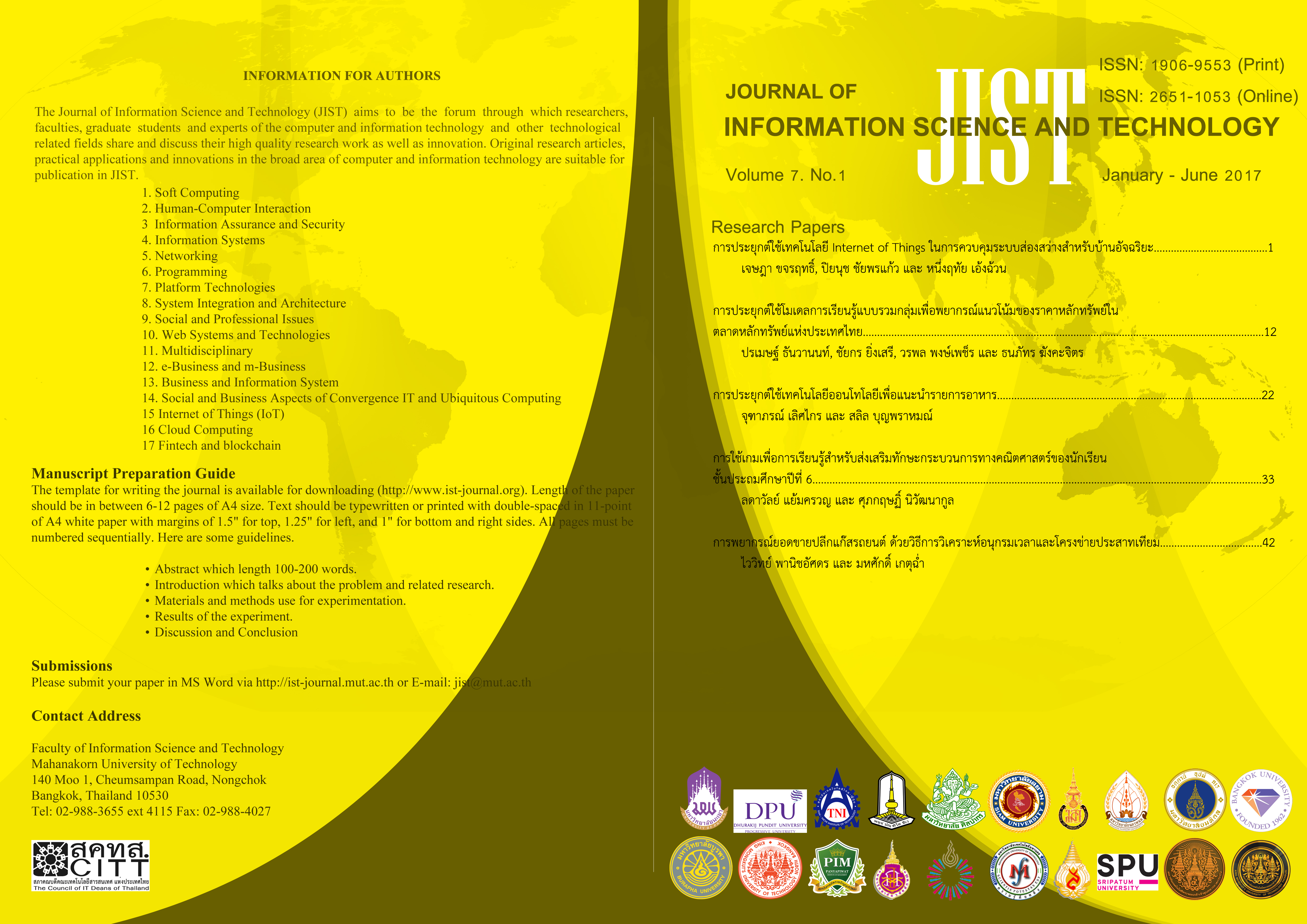การพยากรณ์ยอดขายปลีกแก๊สรถยนต์ด้วยวิธีการวิเคราะห์อนุกรมเวลาและโครงข่ายประสาทเทียม
Main Article Content
บทคัดย่อ
- การพยากรณ์ความต้องการมีบทบาทอย่างมากในการดำเนินธุรกิจปัจจุบัน การจัดการสินค้าคงคลังที่ดีจะสร้างความเปรียบทางการแข่งขัน การมีปริมาณสินค้าคงคลังที่เหมาะสม ไม่มากเกินไปจนทำให้ไม่เหลือเงินไปลงทุนด้านอื่น และไม่น้อยเกินไปจนต้องศูนย์เสียโอกาศในการทำกำไร ในการพยากรณ์ความต้องการหรือยอดขายสำหรับสถานีบริการแก๊สLPG ยิ่งทำได้ยากเพราะมีปัจจัยและข้อมูลจำนวนมาก ที่อาจจะไม่เชื่อมโยงกันหรือเชื่องโยงกันทั้งในทางตรงและทางอ้อม และอาจจะเกิดขึ้นในรูปแบบที่ซ้ำหรือไม่ซ้ำกันก็ได้ ดังนั้นการจะอาศัยข้อมูลย้อนหลังเพียงอย่างเดียวอาจจะไม่สามารถพยากรณ์ได้ จึงจำเป็นที่ระบบพยากรณ์ต้องสามารถเรียนรู้ได้เอง และด้วยเทคนิคโครงข่ายประสาทเทียมนั้น ระบบสามารถที่จะเรียนรู้จากปัจจัยต่าง ๆ และสามารถที่จะสกัดเอาลักษณะออกมาได้เอง จึงทำให้ระบบสามารถรู้ได้ว่า ปัจจัยใดมีผลกระทบต่อความต้องการและปัจจัยใดไม่มีผลต่อความต้องการ ในงานวิจัยนี้ผู้วิจัยได้จึงได้นำวิธีการโครงข่ายประสาทเทียมที่สามารถเรียนรู้รูปแบบต่าง ๆ ที่มีความซับซ้อนได้คล้ายกับวิธีการคิดของมนุษย์เข้ามาเพื่อสร้างโมเดลในการพยากรณ์เพื่อแก้ปัญหาดังกล่าว วิธีการนี้พยากรณ์ได้แม่นยำมากโดยมีค่าผิดพลาดเฉลี่ยเพียงหกร้อยกว่าหน่วยต่อวัน จากยอดขายเฉลี่ยหนึ่งหมื่นต่อวัน
Article Details
This work is licensed under a Creative Commons Attribution-NonCommercial-NoDerivatives 4.0 International License.
I/we certify that I/we have participated sufficiently in the intellectual content, conception and design of this work or the analysis and interpretation of the data (when applicable), as well as the writing of the manuscript, to take public responsibility for it and have agreed to have my/our name listed as a contributor. I/we believe the manuscript represents valid work. Neither this manuscript nor one with substantially similar content under my/our authorship has been published or is being considered for publication elsewhere, except as described in the covering letter. I/we certify that all the data collected during the study is presented in this manuscript and no data from the study has been or will be published separately. I/we attest that, if requested by the editors, I/we will provide the data/information or will cooperate fully in obtaining and providing the data/information on which the manuscript is based, for examination by the editors or their assignees. Financial interests, direct or indirect, that exist or may be perceived to exist for individual contributors in connection with the content of this paper have been disclosed in the cover letter. Sources of outside support of the project are named in the cover letter.
I/We hereby transfer(s), assign(s), or otherwise convey(s) all copyright ownership, including any and all rights incidental thereto, exclusively to the Journal, in the event that such work is published by the Journal. The Journal shall own the work, including 1) copyright; 2) the right to grant permission to republish the article in whole or in part, with or without fee; 3) the right to produce preprints or reprints and translate into languages other than English for sale or free distribution; and 4) the right to republish the work in a collection of articles in any other mechanical or electronic format.
We give the rights to the corresponding author to make necessary changes as per the request of the journal, do the rest of the correspondence on our behalf and he/she will act as the guarantor for the manuscript on our behalf.
All persons who have made substantial contributions to the work reported in the manuscript, but who are not contributors, are named in the Acknowledgment and have given me/us their written permission to be named. If I/we do not include an Acknowledgment that means I/we have not received substantial contributions from non-contributors and no contributor has been omitted.
References
2. Iwan Awaludin, “A Prediction of Oil Demand in Malaysia Using Time Series Modeling approach”, 2008 International Symposium on Information Technology, Vol. 3, September 2008. pp. 1-4
3. Minjie Zhu, “Research of Product Oil Demand Forecast Based on the Combination Forecast Method”, 2010 International Conference on E-Business and E-Government, May 2010. pp. 796-798
4. Chengli Zhang, “Analysis and Forecasting of Oil Demand in China”, 2010 International Conference on E-Business and E-Government, September 2010. pp. 5078-5081
5. Seyedeh Mahya Seyedan, “Performance analysis and forecasting on Crude Oil: Novel Support Vector Regression application to market demand”, 2015 International Conference on Soft Computing Techniques and Implementations (ICSCTI), vol. 3, June 2016. pp. 126-130
6. Mustafa Akpinar and Nejat Yumusak, “Forecasting Household Natural Gas Consumption with ARIMA Model: A Case Study of Removing Cycle”, 2013 7th International Conference on Application of Information and Communication Technologies, January 2014. pp. 1-6
7. Yi-Hui Liang, “Using the combined model for forecasting the tourism demand”, 2016 International Conference on Machine Learning and Cybernetics (ICMLC), vol. 2, March 2017. pp. 612-615
8. Xiaoxiao Guo, "A Prediction-Based Inventory Optimization Using Data Mining Models", 2014 Seventh International Joint Conference on Computational Sciences and Optimization, October 2014. pp. 611-615
9. Thararat Udomchaibanjerd, “NAV Forecasting Model Using Data Mining and Artificial Neural Network”, The Tenth National Conference on Computing and Information Technology 2014, May 2014. pp. 890-895


